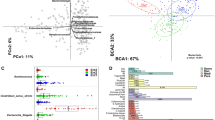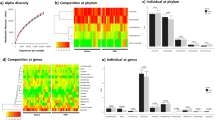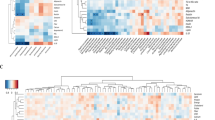Abstract
Background
Obesity is a chronic disease whose pathogenesis has been related to changes in the intestinal microbiota. Yet, the role of protozoa and other unicellular eukaryotic parasites in this microenvironment is still largely unknown. Their presence within the gut ecosystem in obese subjects warrants further study, as well as their influence on the host metabolism and comorbidities.
Methods
Herein, a single center, cross-sectional study of 104 obese individuals was performed to assess the presence of six intestinal unicellular parasites in stool using a commercially available kit, and to evaluate its relationship with the presence of abdominal symptoms, metabolic comorbidities, variations in body composition and nutritional deficiencies.
Results
The overall parasitic colonization rate was 51%, with Blastocystis sp., identified as the most frequent (44.2%), followed by Dientamoeba fragilis (11.5%) and Giardia intestinalis (8.7%), and significantly related to the consumption of ecological fruits and vegetables. Contrary to what previous studies pointed out, colonization with parasites species was significantly associated with fewer abdominal symptoms and depositions per day. The presence of parasites did not correlate with any nutritional deficiencies nor differences in body composition, while it did with significant lower HOMA-IR levels and a lower trend towards metabolic syndrome.
Conclusion
Obese subjects frequently harbor unicellular enteric parasites, apparently without clinical nor nutritional harm. This evidence suggests that carrying these microorganisms, from an endocrinological perspective, has a beneficial effect, especially on insulin resistance and possibly on the development of related comorbidities.
This is a preview of subscription content, access via your institution
Access options
Subscribe to this journal
Receive 12 print issues and online access
$259.00 per year
only $21.58 per issue
Buy this article
- Purchase on Springer Link
- Instant access to full article PDF
Prices may be subject to local taxes which are calculated during checkout


Similar content being viewed by others
References
Costa-Font J, Mas N. ‘Globesity’? The effects of globalization on obesity and caloric intake. Food Policy. 2016;64:121–32.
Vasileva LV, Marchev AS, Georgiev MI. Causes and solutions to “globesity”: the new fa(s)t alarming global epidemic. Food Chem Toxicol. 2018;121:173–93.
Di Angelantonio E, Bhupathiraju SN, Wormser D, Gao P, Kaptoge S, de Gonzalez AB, et al. Body-mass index and all-cause mortality: individual-participant-data meta-analysis of 239 prospective studies in four continents. Lancet. 2016;388:776–86.
Swinburn BA, Sacks G, Hall KD, McPherson K, Finegood DT, Moodie ML, et al. The global obesity pandemic: shaped by global drivers and local environments. Lancet. 2011;378:804–14.
Yumuk V, Tsigos C, Fried M, Schindler K, Busetto L, Micic D, et al. European guidelines for obesity management in adults. Obes Facts. 2015;8:402–24.
Handelsman Y, Bloomgarden ZT, Grunberger G, Umpierrez G, Zimmerman RS, Bailey TS, et al. American association of clinical endocrinologists and American college of endocrinology – clinical practice guidelines for developing a diabetes mellitus comprehensive care plan – 2015. Endocr Pract. 2015;21:1–87.
Joyce SA, Gahan CGM. The gut microbiota and the metabolic health of the host. Curr Opin Gastroenterol. 2014;30:120–7.
Patterson E, Ryan PM, Cryan JF, Dinan TG, Ross RP, Fitzgerald GF, et al. Gut microbiota, obesity and diabetes. Postgrad Med J. 2016;92:286–300.
Sen T, Cawthon CR, Ihde BT, Hajnal A, DiLorenzo PM, de La Serre CB, et al. Diet-driven microbiota dysbiosis is associated with vagal remodelling and obesity. Physiol Behav. 2017;173:305–17.
Chabé M, Lokmer A, Ségurel L. Gut protozoa: friends or foes of the human gut microbiota? Trends Parasitol. 2017;33:925–34.
Burgess SL, Gilchrist CA, Lynn TC, Petri WA. Parasitic protozoa and interactions with the host intestinal microbiota. Infection Immun. 2017;85:e00101–17.
Stensvold CR, van der Giezen M. Associations between gut microbiota and common luminal intestinal parasites. Trends Parasitol. 2018;34:369–77.
Andersen LO, Stensvold CR. Blastocystis in health and disease: are we moving from a clinical to a public health perspective? J Clin Microbiol. 2016;54:524–8.
Beghini F, Pasolli E, Truong TD, Putignani L, Cacciò SM, Segata N. Large-scale comparative metagenomics of Blastocystis, a common member of the human gut microbiome. ISME J. 2017;11:2848–63.
Le Chatelier E, Nielsen T, Qin J, Prifti E, Hildebrand F, Falony G, et al. Richness of human gut microbiome correlates with metabolic markers. Nature. 2013;500:541–6.
Partida-Rodríguez O, Serrano-Vázquez A, Nieves-Ramírez ME, Moran P, Rojas L, Portillo T, et al. Human intestinal microbiota: interaction between parasites and the host immune response. Arch Med Res. 2017;48:690–700.
Bär A, Phukan N, Pinheiro J, Simoes-Barbosa A. The interplay of host microbiota and parasitic protozoans at mucosal interfaces: implications for the outcomes of infections and diseases. PLoS Negl Tropical Dis. 2015;9:e0004176.
Lumeng CN, Bodzin JL, Saltiel AR. Obesity induces a phenotypic switch in adipose tissue macrophage polarization. J Clin Investig. 2007;117:175–84.
Hotamisligil GS. Inflammation and metabolic disorders. Nature. 2006;14,444:860–7.
Saltiel AR, Olefsky JM. Inflammatory mechanisms linking obesity and metabolic disease. J Clin Investig. 2017;3,127:1–4.
Falagas ME, Kompoti M. Obesity and infection. Lancet Infectious Dis. 2006;6:438–46.
Hidalgo L, Salvador F, Sulleiro E, López I, Balladares M, García E, et al. Evaluation of risk factors associated to detection of Blastocystis sp. in fecal samples in population from Barcelona, Spain: a case-control study. Eur J Clin Microbiol Infectious Dis. 2019;38:1241–7.
Pérez y López N, Torres-López E, Zamarripa-Dorsey F. Clinical response in Mexican patients with irritable bowel syndrome treated with a low diet low in fermentable carbohydrates (FODMAP). Revista de Gastroenterología de México. 2015;80:180–5.
Lewis SJ, Heaton KW. Stool form scale as a useful guide to intestinal transit time. Scand J Gastroenterol. 1997;32:920–4.
Huang PL. A comprehensive definition for metabolic syndrome. Dis Models Mech. 2009;2:231–7.
Kim B, Kim HS, Kim JJ, Park YJ, Kim D, Yong D. Detection of intestinal protozoa in Korean patients using BD MAX enteric parasite panel and seegene allplex gastrointestinal parasite assay. Lab Med Online. 2020;10:221–6.
Autier B, Gangneux J, Robert-Gangneux F. Evaluation of the AllplexTM gastrointestinal panel - parasite assay for protozoa detection in stool samples: a retrospective and prospective study. Microorganisms. 2020;8:569.
Galán-Puchades MT, Trelis M, Sáez-Durán S, Cifre S, Gosálvez C, Sanxis-Furió J, et al. One health approach to zoonotic parasites: molecular detection of intestinal protozoans in an urban population of Norway rats, Rattus norvegicus, in Barcelona, Spain. Pathogens. 2021;10:311.
Faria S, Faria O, Cardeal M, Ito M. Validation study of multi-frequency bioelectrical impedance with dual-energy X-ray absorptiometry among obese patients. Obesity Surgery. 2014;24:1476–80.
Gomez-Arbelaez D, Bellido D, Castro AI, Ordoñez-Mayan L, Carreira J, Galban C, et al. Body composition changes after very-low-calorie ketogenic diet in obesity evaluated by 3 standardized methods. J Clin Endocrinol Metabol. 2017;102:488–98.
Ness-Abramof R, Apovian CM. Waist circumference measurement in clinical practice. Nutrition Clin Pract. 2008;23:397–404.
Loaeza-del-Castillo A, Paz-Pineda F, Oviedo-Cárdenas E, Sánchez-Avila F, Vargas-Vorácková F. AST to platelet ratio index (APRI) for the noninvasive evaluation of liver fibrosis. Ann Hepatol. 2008;7:350–7.
Angulo P, Hui JM, Marchesini G, Bugianesi E, George J, Farrell GC, et al. The NAFLD fibrosis score: a noninvasive system that identifies liver fibrosis in patients with NAFLD. Hepatology. 2007;45:846–54.
Papagianni M, Sofogianni A, Tziomalos K. Non-invasive methods for the diagnosis of nonalcoholic fatty liver disease. World J Hepatol. 2015;7:638.
Ampuero J, Aller R, Gallego-Durán R, Banales J, Crespo J, Vilar-Gomez E, et al. Hepamet Score: a new non-invasive method for NAFLD-related fibrosis screening in clinical practice. J Hepatol. 2018;68:S97–S98.
R Core Team. R: a language and environment for statistical computing. R Foundation for Statistical Computing, Vienna, Austria. 2013. Available from: https://www.r-project.org/.
National Heart, Lung, Blood Institute, National Institute of Diabetes, Digestive, Kidney Diseases. Clinical guidelines on the identification, evaluation, and treatment of overweight and obesity in adults: the evidence report.: National Heart, Lung, and Blood Institute; NIH publication, 1998.
Ascaso JF, Real JT, Priego A, Carmena R, Romero P, Valdecabres C. Cuantificación de insulinorresistencia con los valores de insulina basal e índice HOMA en una población no diabética. Med Clín. 2001;117:530–3.
Lhotská Z, Jirků M, Hložková O, Brožová K, Jirsová D, Stensvold CR, et al. A study on the prevalence and subtype diversity of the intestinal protist Blastocystis sp. in a gut-healthy human population in the Czech Republic. Front Cell Infection Microbiol. 2020;10:544335.
Clark CG, van der Giezen M, Alfellani MA, Stensvold CR. Recent developments in Blastocystis research. Adv Parasitol. 2013;82:1–32.
El Safadi D, Gaayeb L, Meloni D, Cian A, Poirier P, Wawrzyniak I, et al. Children of Senegal River Basin show the highest prevalence of Blastocystis sp. ever observed worldwide. BMC Infectious Diseases. 2014;14:164. 25
Paulos S, Köster PC, de Lucio A, Hernández‐de‐Mingo M, Cardona GA, Fernández‐Crespo JC, et al. Occurrence and subtype distribution of Blastocystis sp. in humans, dogs and cats sharing household in northern Spain and assessment of zoonotic transmission risk. Zoonoses Public Health. 2018;65:993–1002.
Scanlan PD, Stensvold CR, Rajilić-Stojanović M, Heilig HGHJ, De Vos WM, O’Toole PW, et al. The microbial eukaryote Blastocystis is a prevalent and diverse member of the healthy human gut microbiota. FEMS Microbiol Ecol. 2014;90:326–30.
Tan KS, Mirza H, Teo JD, Wu B, MacAry PA. Current views on the clinical relevance of Blastocystis spp. Current Infectious Dis Rep. 2010;12:28–35.
Audebert C, Even G, Cian A, Loywick A, Merlin S, Viscogliosi E, et al. Colonization with the enteric protozoa Blastocystis is associated with increased diversity of human gut bacterial microbiota. Sci Rep. 2016;6:25255.
Scanlan PD, Stensvold CR. Blastocystis: getting to grips with our guileful guest. Trends Parasitol. 2013;29:523–9.
Barratt JLN, Harkness J, Marriott D, Ellis JT, Stark D. A review of Dientamoeba fragilis carriage in humans: Several reasons why this organism should be considered in the diagnosis of gastrointestinal illness. Gut Microbes. 2011;2:3–12. 1
Garcia LS. Dientamoeba fragilis, one of the neglected intestinal protozoa. J Clin Microbiol. 2016;54:2243–50.
Stark D, Barratt J, Chan D, Ellis JT. Dientamoeba fragilis, the neglected trichomonad of the human bowel. Clin Microbiol Rev. 2016;29:553–80.
Minetti C, Chalmers RM, Beeching NJ, Probert C, Lamden K. Giardiasis. BMJ. 2016;355:i5369.
Trelis M, Taroncher-Ferrer S, Gozalbo M, Ortiz V, Soriano JM, Osuna A, et al. Giardia intestinalis and fructose malabsorption: a frequent association. Nutrients. 2019;11:2973.
Sabate J, Coupaye M, Ledoux S, Castel B, Msika S, Coffin B, et al. Consequences of small intestinal bacterial overgrowth in obese patients before and after bariatric surgery. Obesity Surgery. 2017;27:599–605.
Madrid AM, Poniachik J, Quera R, Defilippi C. Small intestinal clustered contractions and bacterial overgrowth: a frequent finding in obese patients. Dig Dis Sci. 2011;56:155–60.
Giacometti A, Cirioni O, Fiorentini A, Fortuna M, Scalise G. Irritable bowel syndrome in patients with Blastocystis hominis infection. Eur J Clin Microbiol Infectious Dis. 1999;18:436–9.
Jimenez-Gonzalez DE, Martinez-Flores WA, Reyes-Gordillo J, Ramirez-Miranda ME, Arroyo-Escalante S, Romero-Valdovinos M, et al. Blastocystis infection is associated with irritable bowel syndrome in a Mexican patient population. Parasitol Res. 2012;110:1269–75.
Tungtrongchitr A, Manatsathit S, Kositchaiwat C, Ongrotchanakun J, Munkong N, Chinabutr P, et al. Blastocystis hominis infection in irritable bowel syndrome patients. Southeast Asian J Tropical Med Public Health. 2004;35:705–10.
Surangsrirat S, Thamrongwittawatpong L, Piyaniran W, Naaglor T, Khoprasert C, Taamasri P, et al. Assessment of the association between Blastocystis infection and irritable bowel syndrome. J Med Assoc Thail. 2010;93:119.
Cekin AH, Cekin Y, Adakan Y, Tasdemir E, Koclar FG, Yolcular BO. Blastocystosis in patients with gastrointestinal symptoms: a case–control study. BMC Gastroenterol. 2012;12:1–6.
Krogsgaard LR, Lee O, Johannesen TB, Engsbro AL, Stensvold CR, Nielsen HV, et al. Characteristics of the bacterial microbiome in association with common intestinal parasites in irritable bowel syndrome. Clin Transl Gastroenterol. 2018;9:161.
Lukeš J, Stensvold CR, Jirků-Pomajbíková K, Wegener Parfrey L. Are human intestinal eukaryotes beneficial or commensals? PLoS Pathogens. 2015;11:e1005039.
Acknowledgements
This work was partially supported by a grant from Menarini Spain, SA. The funding enabled the study design, data collection, analysis and interpretation.
Author information
Authors and Affiliations
Contributions
Conceptualization: JFM-T and MT; Methodology: JFM-T, JMS and MT; Formal analysis: JC and MT; Investigation: JC, SC and MT; data curation: JC and SC.; Writing-original draft preparation: JC and MT; Writing-review and editing: JC, JFM-T, JMS and MT; Project administration, JFM-T and MT.
Corresponding author
Ethics declarations
Competing interests
The authors declare no competing interests.
Additional information
Publisher’s note Springer Nature remains neutral with regard to jurisdictional claims in published maps and institutional affiliations.
Supplementary information
Rights and permissions
About this article
Cite this article
Caudet, J., Trelis, M., Cifre, S. et al. Presence and significance of intestinal unicellular parasites in a morbidly obese population. Int J Obes 46, 220–227 (2022). https://doi.org/10.1038/s41366-021-00980-6
Received:
Revised:
Accepted:
Published:
Issue Date:
DOI: https://doi.org/10.1038/s41366-021-00980-6



